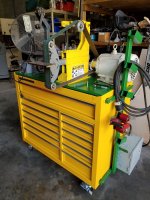Hydroracer
Plastic
- Joined
- Apr 21, 2020
I am building a 2x72 grinder for knife making. A topic of discussion is often how much HP, motor speed and VFD choice.
Since I'm taking the time to make it I want to choose the best motor (speed and HP) and VFD for optimum performance.
One argument says a 3600 RPM 3 HP motor. Another says to go 1800 RPM and 2HP.
The drive wheel will be 5" diameter and at 3600 RPM this produces around 4700 FPM belt surface speed. Target speed should be between 5000 and 6000 FPM for best results with modern low grit ceramic belts (this is for hogging off a lot of steel quickly). Sometimes, I would require slower speeds, but still have the power to apply a good load to it. The smaller the grit, typically the slower you run the speed.
So, would it be better to go with the 1800 RPM motor and achieve the high speeds via higher frequency from the VFD and have more torque at lower speeds, or just go 3600 RPM?
I have a basic comprehension of 3-phase motors and how a VFD works, but just want to be sure I'm not setting things up to where I end up with a failed or burned motor and ensure it can perform as desired.
Since I'm taking the time to make it I want to choose the best motor (speed and HP) and VFD for optimum performance.
One argument says a 3600 RPM 3 HP motor. Another says to go 1800 RPM and 2HP.
The drive wheel will be 5" diameter and at 3600 RPM this produces around 4700 FPM belt surface speed. Target speed should be between 5000 and 6000 FPM for best results with modern low grit ceramic belts (this is for hogging off a lot of steel quickly). Sometimes, I would require slower speeds, but still have the power to apply a good load to it. The smaller the grit, typically the slower you run the speed.
So, would it be better to go with the 1800 RPM motor and achieve the high speeds via higher frequency from the VFD and have more torque at lower speeds, or just go 3600 RPM?
I have a basic comprehension of 3-phase motors and how a VFD works, but just want to be sure I'm not setting things up to where I end up with a failed or burned motor and ensure it can perform as desired.


